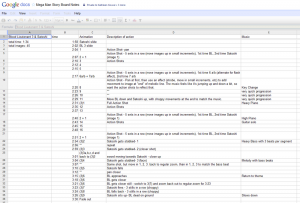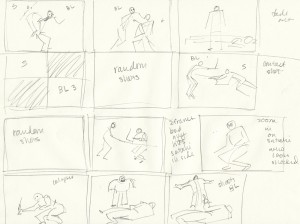I worked closely with Blair when it came to storyboarding for Hideo. Being the producer, she had a vision for how these pieces were going to play out, so my job was to translate her vision to paper, integrating all facets of the artwork I had already created with the story that was still evolving.
At the point when I was ready to work on storyboarding, the music choices had been made and Chris worked at an impressive pace to commit the pieces to sheet music, therefore giving me the final timings for each segment. My job was confined to animating within the musical segments; between each musical number, on-stage characters helped to flesh out the backstory and plot details that either couldn’t be or decidedly were not included in the animations.
Some segments were more straightforward than others, being rather short, panning landscapes such as in “Canta Per Me.” Others were more active and character-heavy, requiring a lot more thought, time, and original artwork, most notably the “Mega Man Medley.” Blair and I worked out the overall plot ideas for each scene, then I listened to the music over and over, marking down the times and translating mental images into rough (and I do mean rough) sketches or even simple descriptions of when I thought images should change and how. For a few of the pieces, I got elbow deep in spreadsheets in an effort to not only give myself a more concrete and precise source to work from, but also to help communicate my intentions to our animation technician (I’ll get into that process in my next post).
- Example of Mega Man Timing Notes
- Example of Mega Man Storyboard
Once I had determined how many stills I needed to make and how they would fit together, I sketched out each pane, first very roughly to get the poses as natural as possible – a daunting task in its own regard when working without live models or reference images. I should say that I did try to get some friends together to act out some battle scenes, but when you’re trying to capture the movement of a person lunging or jumping, your friends’ static poses leave almost as much work to the imagination as if you hadn’t bothered making them wield blow-up plastic swords and “foam roller” weapons. Funny to watch though. I have no regrets.
I do have to say that doing storyboarding has given me a strong appreciation for those who have honed this skill. I feel like there’s so much more that could go into the setup of an animation that I didn’t even come close to touching on. I focused primarily on getting the action poses coordinated, but could have played a bunch with setting the mood, cinematography (or whatever the animation equivalent to that is), and effects. I would be very curious to see how an experienced animator would take on this task.
In my next post, I will delve into more depth about how we got from original artwork to digital animation.










